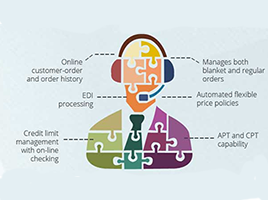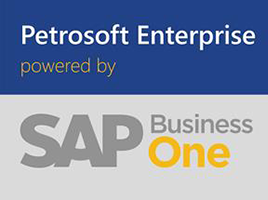A lot of lean purists argue that ERP is naturally at odds with achieving lean and at first glance this might seem like common sense. Lean is all about getting the most out of people, cutting out the white noise created by clumsy systems and streamlining the work process so it is as efficient as possible.
Implementing ERP software is committing to technology and changing the way you work so it matches up with the structure offered by software – it has the potential to create a culture of investing in superfluous work which is not essential to getting the job in hand done, but rather is required for the software to work smoothly.
The reality is that, like any tool, ERP software can without doubt come into line with lean principles, and some would argue is actually essential in truly achieving the lean. The crux of the matter is to ensure you take advantage of the flexibility that ERP software offers and bend it to the will of lean principles. But how? Here I’ll match up the basic five principles of lean to the process of ERP implementation.
1. Specifying Value – Justify New ERP Software
First principle of lean, specify the value of your work and what it offers your customers. To make your process more efficient you need to understand what is delivering value and what isn’t. Once you understand what value is, you’ll find it easier to comb through all activities and clearly understand whether they are delivering or whether they are superfluous.
Remember that there are compulsory activities that don’t add direct value, for example legal requirements such as preparing financial accounts. This process should help you establish whether you need a new ERP solution and what you need to get from it. ERP software can be used to eradicate work which isn’t delivering value. Ultimately it should deliver ROI. This first step should have outlined exactly where the ROI will come from post ERP implementation.
2. Identify Value Stream – Select The Right System
The second lean principle involves examining business processes to figure out where activities deliver value and where they don’t. The lean principle here is to separate the wheat from the chaff. This should also start the process of thinking about which ERP system is most appropriate for the business.
There tend to be three types of activity:
- Activities that add no value.
- Activities that add value but are inefficient.
- Activities that add value and are efficient.
- Activities that add no value
An example that I often use to explain activities with no value is a company who used to manually record each sales, purchase and works order in a book. They did this to ensure they could re-produce data should their system crash, but there system hadn’t crashed in two years. The original issue was that before they brought in an IT administrator two years ago, their system had crashed regularly. Since they’d invested in IT they’d had no problems, meaning the problem which pushed them to record data manually had been solved.
These are the kinds of activities that businesses can get locked into, but that do not offer any value. These can simply be excluded from the system specification from the off, and the poor employees responsible for the tedious task of rekeying will no doubt be delighted.
Activities that add value but are inefficient
These activities need to feature in the system specification, but the ERP software should be designed to make them efficient. These are normally activities that provide something for the customer, but go beyond the current systems capabilities so that bespoke or manual processes have to be put in place to deliver value.
Activities that add value and are efficient
It’s easy to forget about these activities when putting together a system specification but it is vital that the new system allows you to continue with processes that are working well.
3. Flow – The ERP Implementation
In lean, flow is all about ensuring that the business processes are married together so that there are no interruptions or unnecessary detours in getting the final product out to the customer. In real terms this involves ensuring both physical flows and logical flows are in line. Physical flows include materials, finished goods, paperwork and the like, and logical flows mean how information is passed around and how system transactions are carried out etc.
The flow of information is an absolutely critical factor in the success of your organisation, but it is all too easily overlooked. In terms of ERP, your flow is created during the implementation phase of your new system. At the implementation stage companies are often keen to get the thing live and then iron out any issues after. This is something you should avoid.
Changes in process should be planned out prior to implementation – if you are keen to implement lean at the same time as ERP then this should be planned out before the system is implemented. Your new ERP implementation should help to deliver a better flow. The software should offer capabilities which make activities more efficient, thereby improving flow.
One example of this is a company which had four different branches individually purchasing stock from the same supplier. Since the purchasing wasn’t centralised it decreased bargaining power over price and it cost more as four people were put into producing one purchase order, rather than one person doing this. The new ERP software had the functionality to allow for centralised purchasing improving this process and freeing up three people to do other value-adding tasks.
4. Pull – Implementation Phase 2
Pull is similar to flow, but relates to how different departments make demands on each other and thereby “pull” them into doing certain actions, whereas flow often references processes within the same department. Pull comes into play when more complex mechanisms are implemented in the second phase, normally after the basics have been put in place.
Workflow is now available in most ERP systems and this is the perfect tool for improving pull between departments as long as organisations have developed procedures and disciplines that are in line with lean, otherwise administration can simply be increased instead of value being added.
5. Perfection – Reviewing Your System
This is something I always preach when talking about ERP implementation and it is absolutely essential in achieving an authentically lean ERP solution. It is also frequently the last thing an organisation wants to do after going through the toll of implementing ERP software!
But it’s so worth doing. Organisations that don’t continue to work on the relationship between their processes and their system will never get full payback. Reviewing this system means properly resourcing this area so that it can be kept an eye on. A system shouldn’t be left solely to an IT Manager to keep an eye on. You should employ business analysts to report back on the success of the system.
Author: Cathie Hall – Managing Director at K3 Syspro, the UK vendors of SYSPRO ERP software







